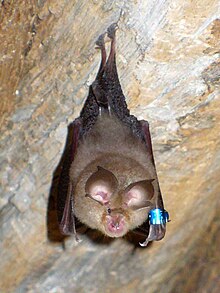Lesser horseshoe bat
| Lesser horseshoe bat | |
|---|---|
 |
|
| A lesser horseshoe bat in France | |
| Scientific classification | |
| Kingdom: | Animalia |
| Phylum: | Chordata |
| Class: | Mammalia |
| Order: | Chiroptera |
| Family: | Rhinolophidae |
| Genus: | Rhinolophus |
| Species: | R. hipposideros |
| Binomial name | |
|
Rhinolophus hipposideros (Bechstein, 1800) |
|
 |
|
| Lesser horseshoe bat range | |
The lesser horseshoe bat (Rhinolophus hipposideros), is a type of European bat related to but smaller than its cousin, the greater horseshoe bat. The species gets its name from its distinctive horseshoe-shaped nose.
The lesser horseshoe bat is one of the world's smallest bats, weighing only 5 to 9 grams, with a wingspan of 192–254 mm and a body length of 35–45 mm. It has strong feet that it uses to grasp rocks and branches, and can see well in spite of its small eyes. Like most bats, lesser horseshoe bats live in colonies and hunt their prey by echolocation, emitting ultrasound from specialized round pads in their mouth.
The base of its fur, which is soft and fluffy, is light grey in colour, with dorsal side fur smoky brown and the ventral side grey, with the exception of juvenile bats which are entirely dark grey. Ears and wing membranes are a light greyish brown.
When hunting they are quick and agile, often flying within five metres of the ground while avoiding contact with bushes and shrubs. The lesser horseshoe bat eats small insects, most of which are gleaned from stones and branches. Their favorite types of prey include flies, moths, and spiders.
Lesser horseshoe bats mate in the autumn. Females give birth to one pup, normally between mid-June and the beginning of July. Pups weigh around 1.8 grams at birth, opening their eyes after around 10 days and becoming independent at six to seven weeks of age. The bats hibernate during the winter months in dark caves, mines, old buildings, and sometimes in cellars.
Females become sexually mature within their first year, with a study in Czechoslovakia showing that about 15% of females give birth at one year of age. Animals have been seen to chase each other as a preliminary to mating, which is done with the male hanging himself behind and over the female.
Nurseries are often shared with other species, such as the greater mouse-eared bat, but there is no direct mixing with other species. The move to nurseries occurs from April onwards, with between 10 and 100 females present and between 2 and 20 males. Approximately two-thirds of females in a nursery roost give birth between mid-June and mid-July.
...
Wikipedia

